UKZN ANTH 102 Essay: Exploring Identity Through Race and Ethnicity
VerifiedAdded on 2022/09/26
|6
|1475
|23
Essay
AI Summary
This essay explores the multifaceted concept of identity within the social categories of race and ethnicity. It examines how these factors, alongside elements like culture and language, shape an individual's sense of self and belonging. The essay delves into the historical evolution of race and ethnicity, highlighting their impact on societal structures and individual experiences. It addresses the positive aspects of racial and ethnic identity, such as fostering unity and a sense of community, while also acknowledging the negative consequences, including discrimination and social divisions. The author discusses the self in society, emphasizing how racial and ethnic affiliations influence an individual's interactions and perceptions. The essay concludes by reiterating the importance of understanding identity in terms of race and ethnicity, acknowledging the complexities and contradictions inherent in these social constructs.
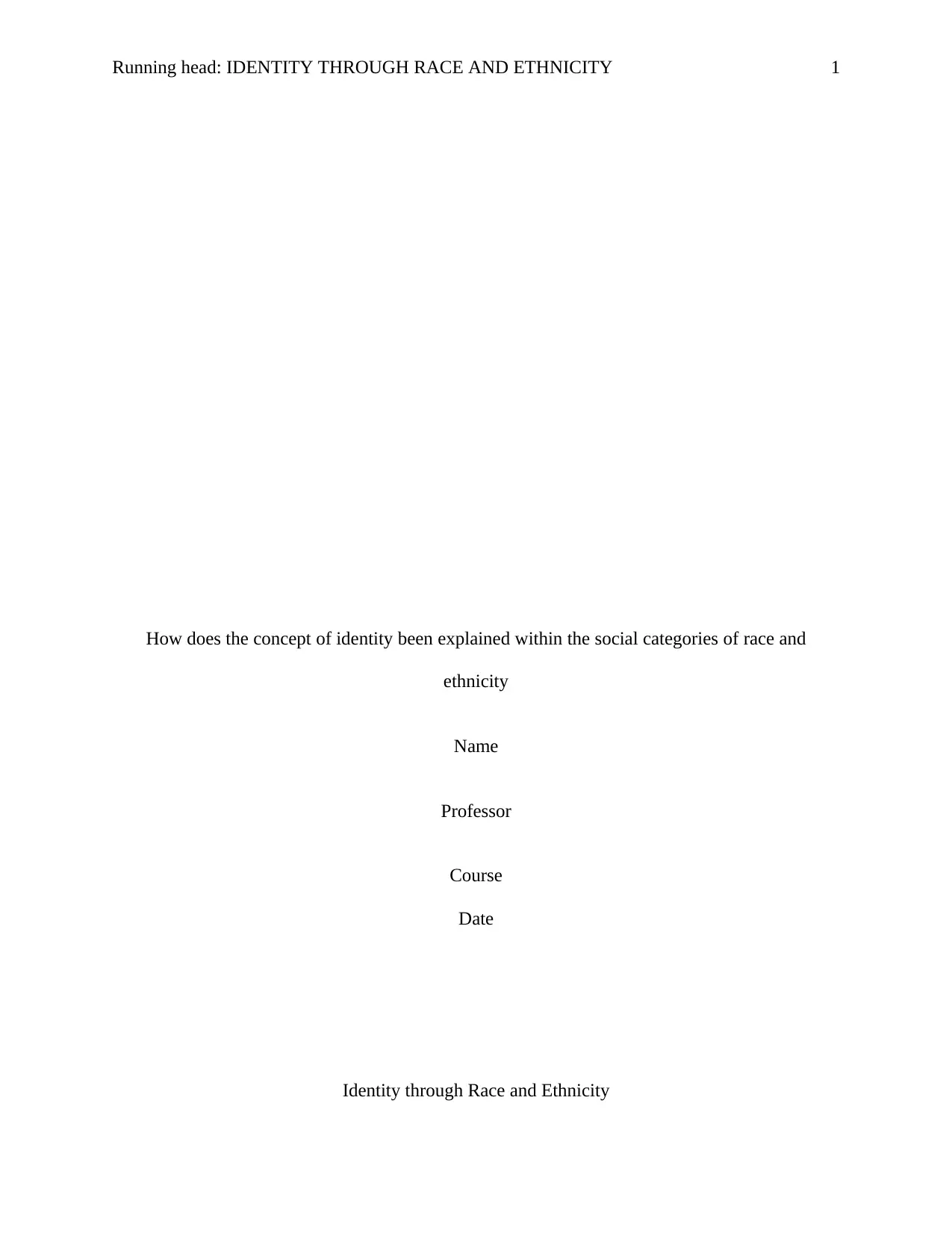
Running head: IDENTITY THROUGH RACE AND ETHNICITY 1
How does the concept of identity been explained within the social categories of race and
ethnicity
Name
Professor
Course
Date
Identity through Race and Ethnicity
How does the concept of identity been explained within the social categories of race and
ethnicity
Name
Professor
Course
Date
Identity through Race and Ethnicity
Paraphrase This Document
Need a fresh take? Get an instant paraphrase of this document with our AI Paraphraser
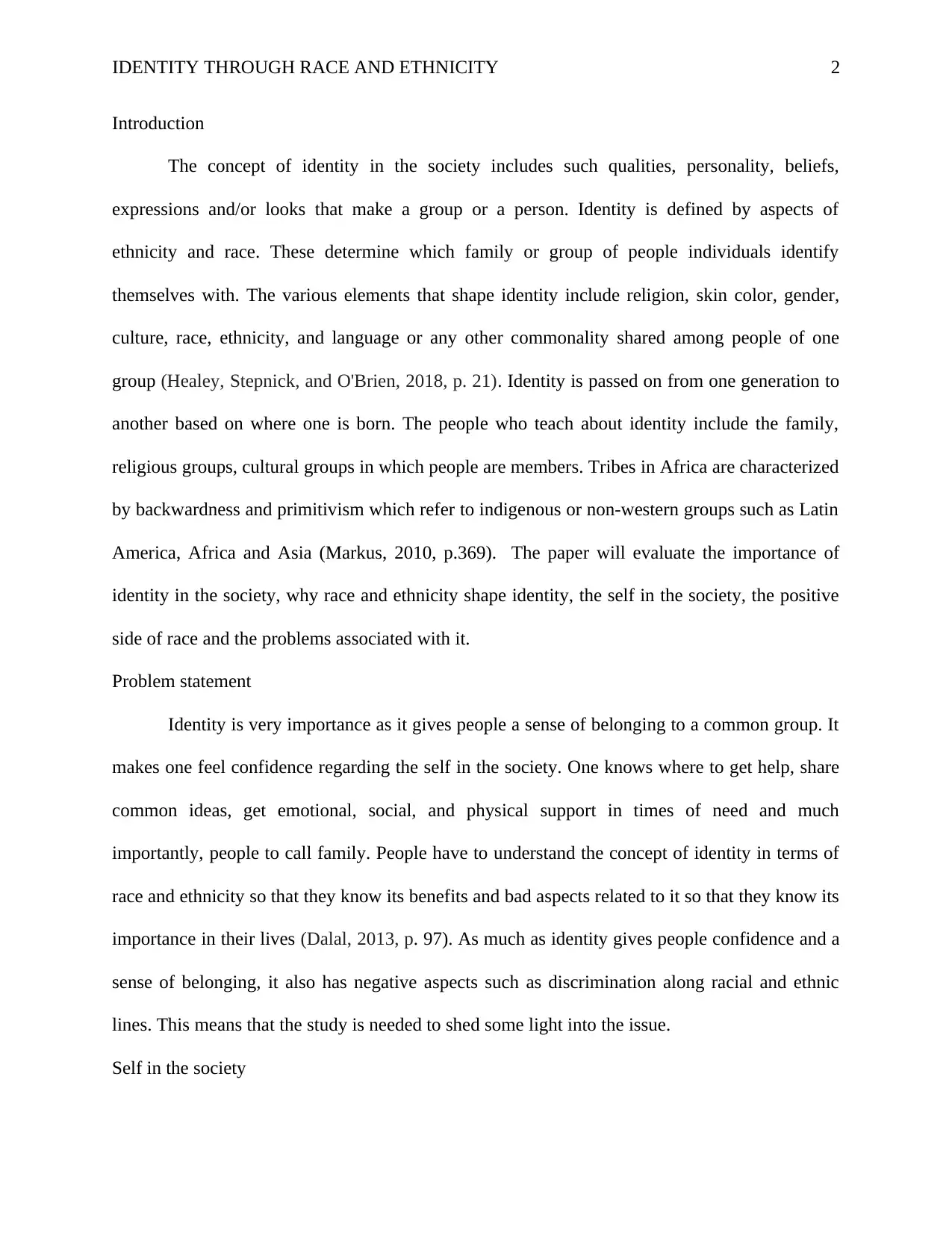
IDENTITY THROUGH RACE AND ETHNICITY 2
Introduction
The concept of identity in the society includes such qualities, personality, beliefs,
expressions and/or looks that make a group or a person. Identity is defined by aspects of
ethnicity and race. These determine which family or group of people individuals identify
themselves with. The various elements that shape identity include religion, skin color, gender,
culture, race, ethnicity, and language or any other commonality shared among people of one
group (Healey, Stepnick, and O'Brien, 2018, p. 21). Identity is passed on from one generation to
another based on where one is born. The people who teach about identity include the family,
religious groups, cultural groups in which people are members. Tribes in Africa are characterized
by backwardness and primitivism which refer to indigenous or non-western groups such as Latin
America, Africa and Asia (Markus, 2010, p.369). The paper will evaluate the importance of
identity in the society, why race and ethnicity shape identity, the self in the society, the positive
side of race and the problems associated with it.
Problem statement
Identity is very importance as it gives people a sense of belonging to a common group. It
makes one feel confidence regarding the self in the society. One knows where to get help, share
common ideas, get emotional, social, and physical support in times of need and much
importantly, people to call family. People have to understand the concept of identity in terms of
race and ethnicity so that they know its benefits and bad aspects related to it so that they know its
importance in their lives (Dalal, 2013, p. 97). As much as identity gives people confidence and a
sense of belonging, it also has negative aspects such as discrimination along racial and ethnic
lines. This means that the study is needed to shed some light into the issue.
Self in the society
Introduction
The concept of identity in the society includes such qualities, personality, beliefs,
expressions and/or looks that make a group or a person. Identity is defined by aspects of
ethnicity and race. These determine which family or group of people individuals identify
themselves with. The various elements that shape identity include religion, skin color, gender,
culture, race, ethnicity, and language or any other commonality shared among people of one
group (Healey, Stepnick, and O'Brien, 2018, p. 21). Identity is passed on from one generation to
another based on where one is born. The people who teach about identity include the family,
religious groups, cultural groups in which people are members. Tribes in Africa are characterized
by backwardness and primitivism which refer to indigenous or non-western groups such as Latin
America, Africa and Asia (Markus, 2010, p.369). The paper will evaluate the importance of
identity in the society, why race and ethnicity shape identity, the self in the society, the positive
side of race and the problems associated with it.
Problem statement
Identity is very importance as it gives people a sense of belonging to a common group. It
makes one feel confidence regarding the self in the society. One knows where to get help, share
common ideas, get emotional, social, and physical support in times of need and much
importantly, people to call family. People have to understand the concept of identity in terms of
race and ethnicity so that they know its benefits and bad aspects related to it so that they know its
importance in their lives (Dalal, 2013, p. 97). As much as identity gives people confidence and a
sense of belonging, it also has negative aspects such as discrimination along racial and ethnic
lines. This means that the study is needed to shed some light into the issue.
Self in the society
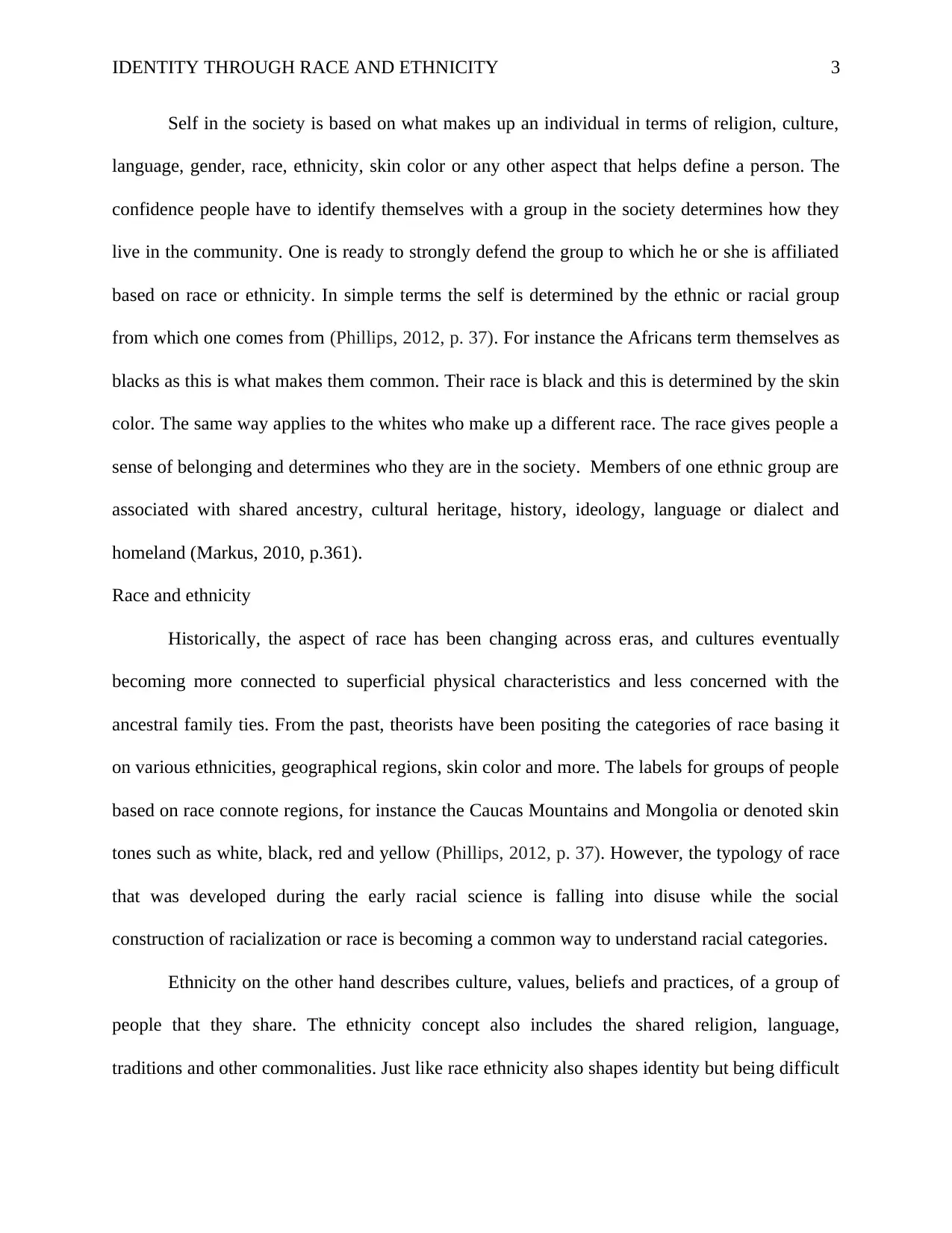
IDENTITY THROUGH RACE AND ETHNICITY 3
Self in the society is based on what makes up an individual in terms of religion, culture,
language, gender, race, ethnicity, skin color or any other aspect that helps define a person. The
confidence people have to identify themselves with a group in the society determines how they
live in the community. One is ready to strongly defend the group to which he or she is affiliated
based on race or ethnicity. In simple terms the self is determined by the ethnic or racial group
from which one comes from (Phillips, 2012, p. 37). For instance the Africans term themselves as
blacks as this is what makes them common. Their race is black and this is determined by the skin
color. The same way applies to the whites who make up a different race. The race gives people a
sense of belonging and determines who they are in the society. Members of one ethnic group are
associated with shared ancestry, cultural heritage, history, ideology, language or dialect and
homeland (Markus, 2010, p.361).
Race and ethnicity
Historically, the aspect of race has been changing across eras, and cultures eventually
becoming more connected to superficial physical characteristics and less concerned with the
ancestral family ties. From the past, theorists have been positing the categories of race basing it
on various ethnicities, geographical regions, skin color and more. The labels for groups of people
based on race connote regions, for instance the Caucas Mountains and Mongolia or denoted skin
tones such as white, black, red and yellow (Phillips, 2012, p. 37). However, the typology of race
that was developed during the early racial science is falling into disuse while the social
construction of racialization or race is becoming a common way to understand racial categories.
Ethnicity on the other hand describes culture, values, beliefs and practices, of a group of
people that they share. The ethnicity concept also includes the shared religion, language,
traditions and other commonalities. Just like race ethnicity also shapes identity but being difficult
Self in the society is based on what makes up an individual in terms of religion, culture,
language, gender, race, ethnicity, skin color or any other aspect that helps define a person. The
confidence people have to identify themselves with a group in the society determines how they
live in the community. One is ready to strongly defend the group to which he or she is affiliated
based on race or ethnicity. In simple terms the self is determined by the ethnic or racial group
from which one comes from (Phillips, 2012, p. 37). For instance the Africans term themselves as
blacks as this is what makes them common. Their race is black and this is determined by the skin
color. The same way applies to the whites who make up a different race. The race gives people a
sense of belonging and determines who they are in the society. Members of one ethnic group are
associated with shared ancestry, cultural heritage, history, ideology, language or dialect and
homeland (Markus, 2010, p.361).
Race and ethnicity
Historically, the aspect of race has been changing across eras, and cultures eventually
becoming more connected to superficial physical characteristics and less concerned with the
ancestral family ties. From the past, theorists have been positing the categories of race basing it
on various ethnicities, geographical regions, skin color and more. The labels for groups of people
based on race connote regions, for instance the Caucas Mountains and Mongolia or denoted skin
tones such as white, black, red and yellow (Phillips, 2012, p. 37). However, the typology of race
that was developed during the early racial science is falling into disuse while the social
construction of racialization or race is becoming a common way to understand racial categories.
Ethnicity on the other hand describes culture, values, beliefs and practices, of a group of
people that they share. The ethnicity concept also includes the shared religion, language,
traditions and other commonalities. Just like race ethnicity also shapes identity but being difficult
⊘ This is a preview!⊘
Do you want full access?
Subscribe today to unlock all pages.

Trusted by 1+ million students worldwide
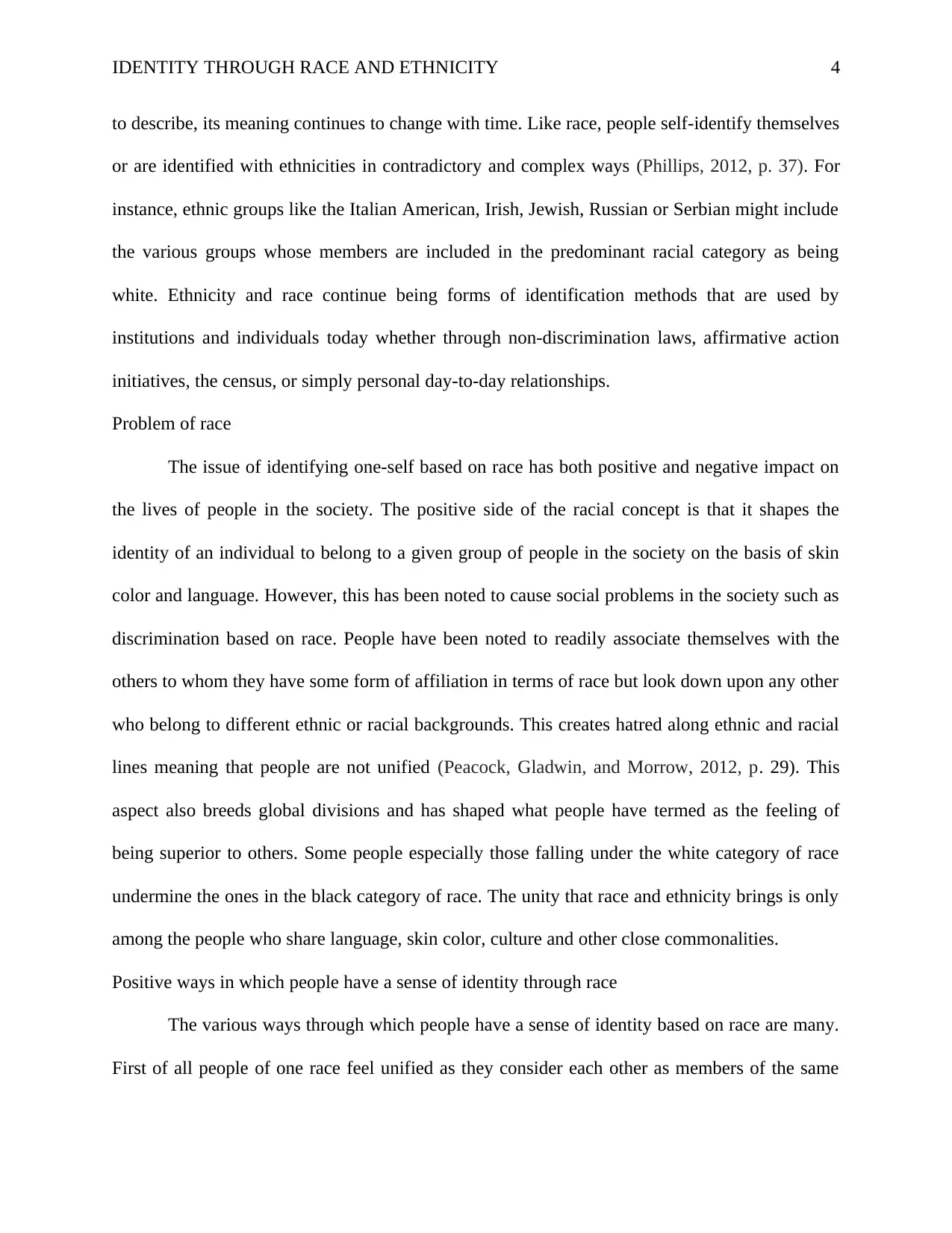
IDENTITY THROUGH RACE AND ETHNICITY 4
to describe, its meaning continues to change with time. Like race, people self-identify themselves
or are identified with ethnicities in contradictory and complex ways (Phillips, 2012, p. 37). For
instance, ethnic groups like the Italian American, Irish, Jewish, Russian or Serbian might include
the various groups whose members are included in the predominant racial category as being
white. Ethnicity and race continue being forms of identification methods that are used by
institutions and individuals today whether through non-discrimination laws, affirmative action
initiatives, the census, or simply personal day-to-day relationships.
Problem of race
The issue of identifying one-self based on race has both positive and negative impact on
the lives of people in the society. The positive side of the racial concept is that it shapes the
identity of an individual to belong to a given group of people in the society on the basis of skin
color and language. However, this has been noted to cause social problems in the society such as
discrimination based on race. People have been noted to readily associate themselves with the
others to whom they have some form of affiliation in terms of race but look down upon any other
who belong to different ethnic or racial backgrounds. This creates hatred along ethnic and racial
lines meaning that people are not unified (Peacock, Gladwin, and Morrow, 2012, p. 29). This
aspect also breeds global divisions and has shaped what people have termed as the feeling of
being superior to others. Some people especially those falling under the white category of race
undermine the ones in the black category of race. The unity that race and ethnicity brings is only
among the people who share language, skin color, culture and other close commonalities.
Positive ways in which people have a sense of identity through race
The various ways through which people have a sense of identity based on race are many.
First of all people of one race feel unified as they consider each other as members of the same
to describe, its meaning continues to change with time. Like race, people self-identify themselves
or are identified with ethnicities in contradictory and complex ways (Phillips, 2012, p. 37). For
instance, ethnic groups like the Italian American, Irish, Jewish, Russian or Serbian might include
the various groups whose members are included in the predominant racial category as being
white. Ethnicity and race continue being forms of identification methods that are used by
institutions and individuals today whether through non-discrimination laws, affirmative action
initiatives, the census, or simply personal day-to-day relationships.
Problem of race
The issue of identifying one-self based on race has both positive and negative impact on
the lives of people in the society. The positive side of the racial concept is that it shapes the
identity of an individual to belong to a given group of people in the society on the basis of skin
color and language. However, this has been noted to cause social problems in the society such as
discrimination based on race. People have been noted to readily associate themselves with the
others to whom they have some form of affiliation in terms of race but look down upon any other
who belong to different ethnic or racial backgrounds. This creates hatred along ethnic and racial
lines meaning that people are not unified (Peacock, Gladwin, and Morrow, 2012, p. 29). This
aspect also breeds global divisions and has shaped what people have termed as the feeling of
being superior to others. Some people especially those falling under the white category of race
undermine the ones in the black category of race. The unity that race and ethnicity brings is only
among the people who share language, skin color, culture and other close commonalities.
Positive ways in which people have a sense of identity through race
The various ways through which people have a sense of identity based on race are many.
First of all people of one race feel unified as they consider each other as members of the same
Paraphrase This Document
Need a fresh take? Get an instant paraphrase of this document with our AI Paraphraser
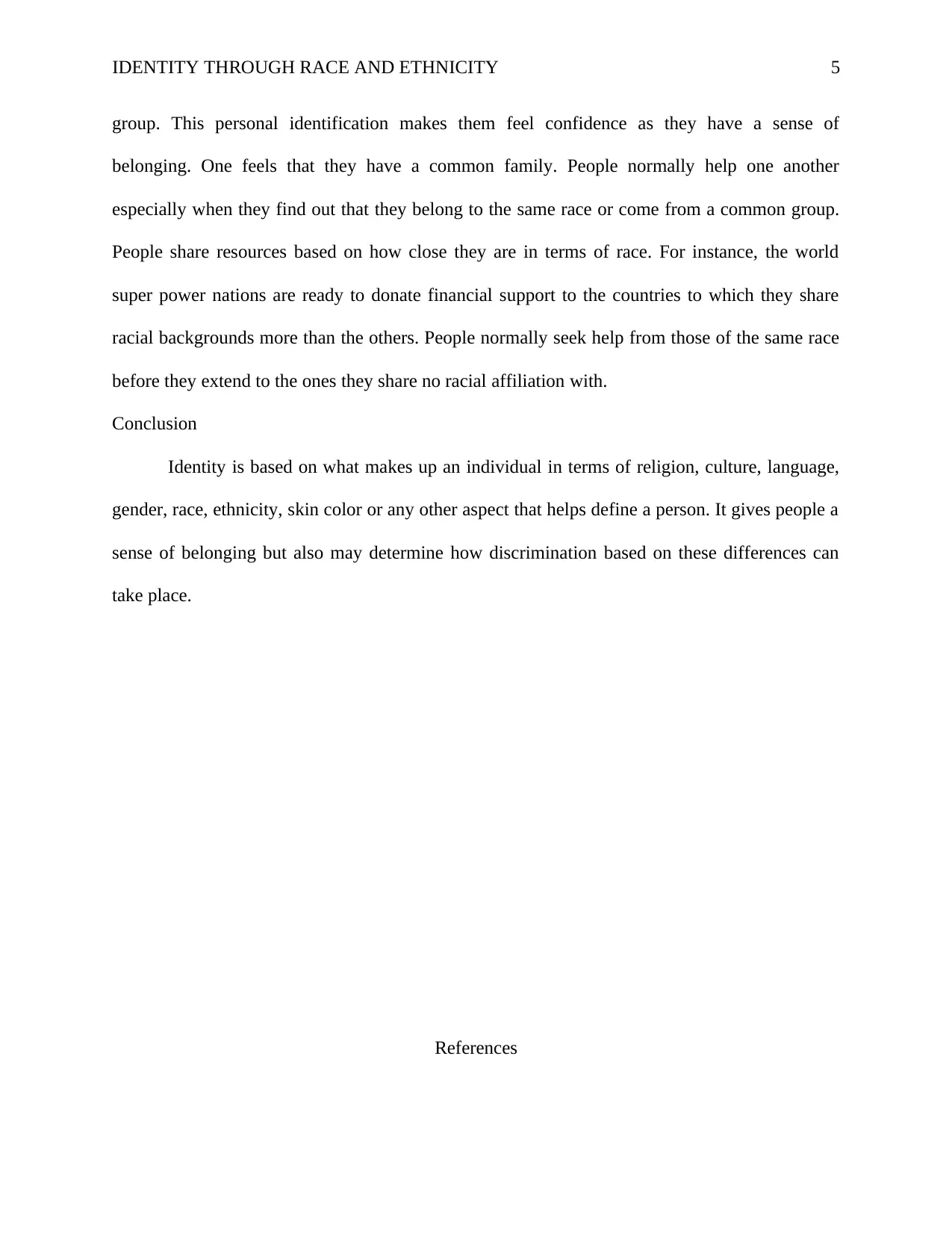
IDENTITY THROUGH RACE AND ETHNICITY 5
group. This personal identification makes them feel confidence as they have a sense of
belonging. One feels that they have a common family. People normally help one another
especially when they find out that they belong to the same race or come from a common group.
People share resources based on how close they are in terms of race. For instance, the world
super power nations are ready to donate financial support to the countries to which they share
racial backgrounds more than the others. People normally seek help from those of the same race
before they extend to the ones they share no racial affiliation with.
Conclusion
Identity is based on what makes up an individual in terms of religion, culture, language,
gender, race, ethnicity, skin color or any other aspect that helps define a person. It gives people a
sense of belonging but also may determine how discrimination based on these differences can
take place.
References
group. This personal identification makes them feel confidence as they have a sense of
belonging. One feels that they have a common family. People normally help one another
especially when they find out that they belong to the same race or come from a common group.
People share resources based on how close they are in terms of race. For instance, the world
super power nations are ready to donate financial support to the countries to which they share
racial backgrounds more than the others. People normally seek help from those of the same race
before they extend to the ones they share no racial affiliation with.
Conclusion
Identity is based on what makes up an individual in terms of religion, culture, language,
gender, race, ethnicity, skin color or any other aspect that helps define a person. It gives people a
sense of belonging but also may determine how discrimination based on these differences can
take place.
References
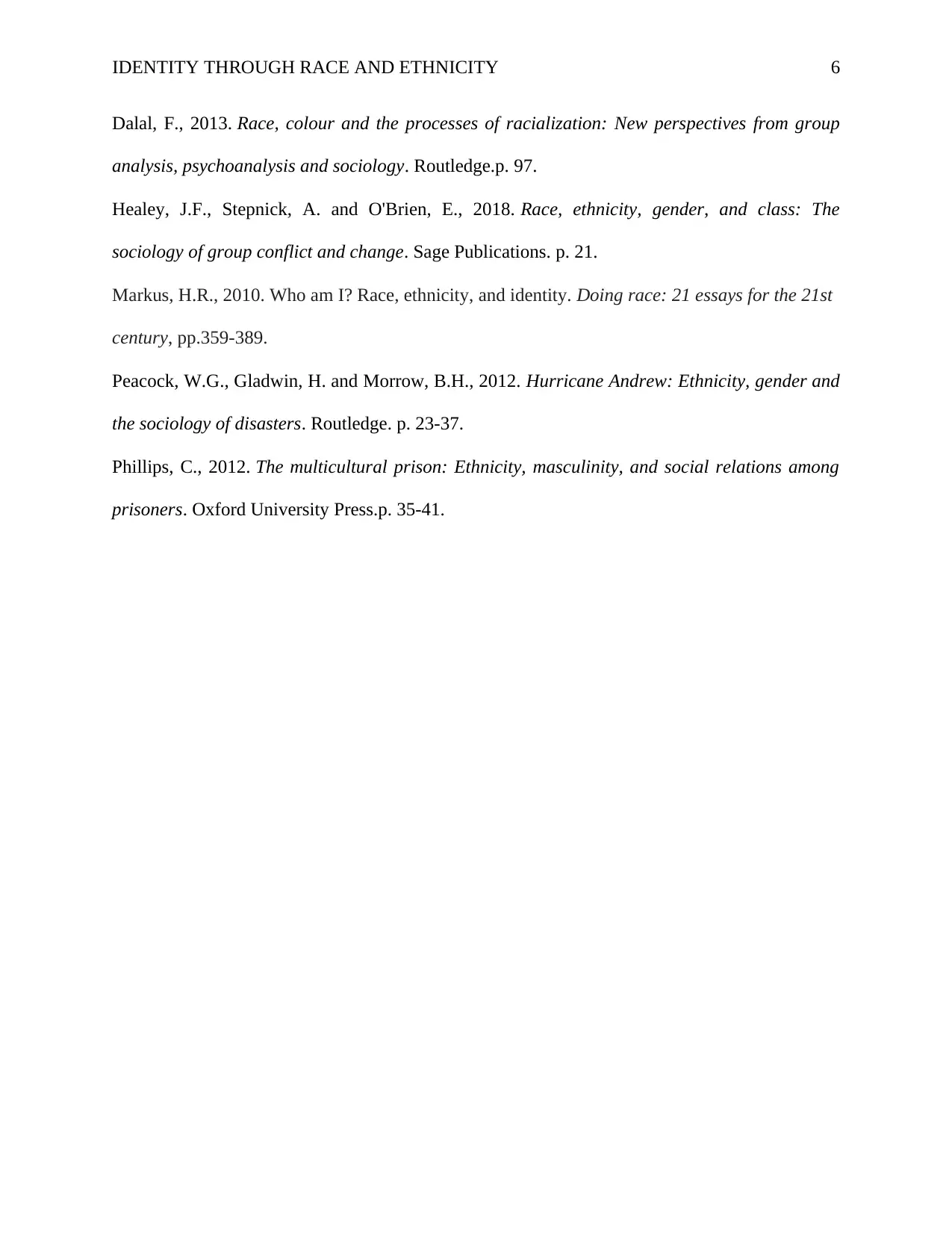
IDENTITY THROUGH RACE AND ETHNICITY 6
Dalal, F., 2013. Race, colour and the processes of racialization: New perspectives from group
analysis, psychoanalysis and sociology. Routledge.p. 97.
Healey, J.F., Stepnick, A. and O'Brien, E., 2018. Race, ethnicity, gender, and class: The
sociology of group conflict and change. Sage Publications. p. 21.
Markus, H.R., 2010. Who am I? Race, ethnicity, and identity. Doing race: 21 essays for the 21st
century, pp.359-389.
Peacock, W.G., Gladwin, H. and Morrow, B.H., 2012. Hurricane Andrew: Ethnicity, gender and
the sociology of disasters. Routledge. p. 23-37.
Phillips, C., 2012. The multicultural prison: Ethnicity, masculinity, and social relations among
prisoners. Oxford University Press.p. 35-41.
Dalal, F., 2013. Race, colour and the processes of racialization: New perspectives from group
analysis, psychoanalysis and sociology. Routledge.p. 97.
Healey, J.F., Stepnick, A. and O'Brien, E., 2018. Race, ethnicity, gender, and class: The
sociology of group conflict and change. Sage Publications. p. 21.
Markus, H.R., 2010. Who am I? Race, ethnicity, and identity. Doing race: 21 essays for the 21st
century, pp.359-389.
Peacock, W.G., Gladwin, H. and Morrow, B.H., 2012. Hurricane Andrew: Ethnicity, gender and
the sociology of disasters. Routledge. p. 23-37.
Phillips, C., 2012. The multicultural prison: Ethnicity, masculinity, and social relations among
prisoners. Oxford University Press.p. 35-41.
⊘ This is a preview!⊘
Do you want full access?
Subscribe today to unlock all pages.

Trusted by 1+ million students worldwide
1 out of 6
Related Documents
Your All-in-One AI-Powered Toolkit for Academic Success.
+13062052269
info@desklib.com
Available 24*7 on WhatsApp / Email
![[object Object]](/_next/static/media/star-bottom.7253800d.svg)
Unlock your academic potential
Copyright © 2020–2025 A2Z Services. All Rights Reserved. Developed and managed by ZUCOL.





